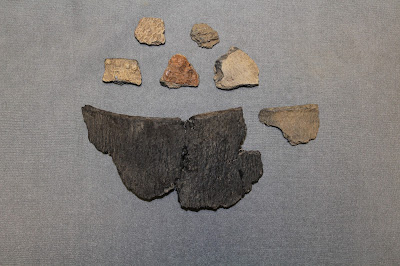This week, we continue our celebration
of the 50thanniversary of the opening of The State Museum of
Pennsylvania in 1965 with a trip down memory lane to the early 1970s.
The 1970s were fruitful times for the Pennsylvania archaeology as interest in the less explored areas of PA arose. A major climatic
disaster hit much of the eastern coast of the United States including a large
area of central Pennsylvania. In late June of 1972, Tropical Storm Agnes tormented
Pennsylvania with torrential rains lasting for a week. Agnes struck with winds between 25-45 mph and
heavy rains across the area, causing rivers and creeks to rise at alarming
rates. Flooding removed large amounts
of earth and buried artifacts from archaeological sites were cropping up to the
surface, causing great concern for the loss of this culture history.
For one curious archaeology student, William
Turnbaugh, the Lycoming Creek Valley and section of the West Branch Valley of
the Susquehanna River in Lycoming county was one of those archaeologically
untapped regions of Pennsylvania. Turnbaugh became interested in archaeology
and basketry in particular in the early 60s when he was given the opportunity
to handle the remains of the collections from the Lycoming County historical
society as he assisted in the moving of the collections to the New Museum, now
the Thomas T. Taber Museum, after a fire at the previous location. By 1967, as
a high school student, Turnbaugh became vice president and acting president of
the New Museum and in 1970 he left for a college education at Harvard
University. So, with an interest in north-central Pennsylvania and specifically
Lycoming county and growing up there Turnbaugh turned this interest into his
doctoral dissertation.
After receiving
an NSF grant he began his dissertation in 1972 just two days after the peak of
the Agnes flooding. He describes the scene as,
“Scores of vacant windows stared from towns of
muddy homes, apartments, stores and churches, all looking out onto lawns and
trees and streets filled with yet more of the stinking oily mud… One marveled
at the boats and campers and travel trailers and cars cluttered together at
various eddy points… Everywhere there were trees and other natural debris;
houses, chicken coops, outhouses and barn roofs; jewelry, silverware,
typewriters, television; mementos and family photos and books.” (Turnbaugh 1973;
66-67)
Turnbaugh’s
survey which is known as the West Branch Survey spanned over a large area of
Lycoming and eastern Clinton counties focusing on localities near the river and
streams. The survey covered more than 160 miles of terrain and uncovered 53
prehistoric sites ranging back as far as the Paleoindian period (11700 BP-19800
BP) through the Contact period (1650 AD-1550 AD). Artifacts recovered included projectile points
from throughout all of our time periods as well as pottery and other stone
tools.
various points from Turnbaugh's survey
net sinkers and groundstone tools from Turnbaugh's survey
prehistoric ceramics from Turnbaugh's survey
knife/scraper and broken drill base from Turnbaugh's survey
Overall, William
Turnbaugh played a major part in our understanding of how geology and the environment factors into site
development in this region of the state. He also developed and improved our
understanding of the prehistoric cultural history of the region and recording extent archaeological
sites from the Susquehanna River basin.
References:
Turnbaugh, William
1973 Cultural Prehistory and Demographic Patterns in North-Central
Pennsylvania. Manuscript on file, Section of Archaeology, State Museum of
Pennsylvania.
1977 Man, Land, And Time; The Cultural Prehistory and Demographic Patterns
of North-Central Pennsylvania. Unigraphic, Inc., Evansville, Indiana.
United
States Department of Commerce National Oceanic and Atmospheric Administration
1973 Final Report of the Disaster Survey Team on the Events of Agnes: A
Report to the Administrator. Natural Disaster Survey Report 73-1. Copy
available at http://www.nws.noaa.gov/om/assessments/pdfs/Hurricane%20Agnes%201972.pdf.
For more information, visit PAarchaeology.state.pa.us or the Hall of Anthropology and Archaeology at The State Museum of Pennsylvania .







No comments:
Post a Comment